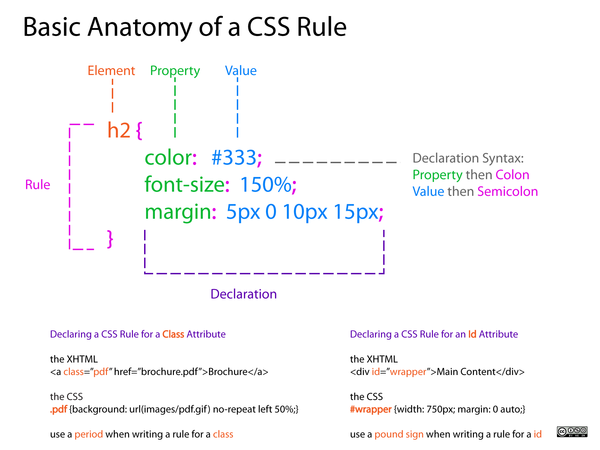Courses/Design & Technique-Essential Web Design/03
HTML div and span
<div> tag =
The div tag is essentially a square container for other content.
<div style="background:black; color:red; width:400px; height: 400px">
<h1>Beautiful page</h1>
<p>writing stuff
<i>inside</i>
</p>
</div>
Abstract Browsing is a Chrome extension by Rafaël Rozendaal that transforms web pages into colored divs.
span tag
<div style="background:black; color:red; width:400px; height: 400px">
<h1>Beautiful page</h1>
<p>writing stuff
<i>inside</i>
</p>
</div>
UTF-8 Encoding
Use more than ASCII characters by telling to the browser your page uses UTF-8 encoding scheme.
UTF-8 can represent any character in the Unicode table, including emoji, Chinese, Arabic, Greek, etc characters.
<!DOCTYPE html>
<html>
<head>
<meta charset="UTF-8" />
<title>😹<</title>
</head>
</html>
<body>
<h1>😹<s page</h1>
</body>
</html>
Styling your page with CSS
CSS - Cascading Style Sheets
HTML is not meant to style (inline syling eg:
- HTML tell the browser what content it should display
- CSS tells the browser how to display that content.
CSS inside an HTML page
- CSS code goes inside the style tags
<style> ... </style> <style> ... </style>tags are placed inside the head of the HTML page.
<!DOCTYPE html>
<html>
<head>
<style>
body{
background: #FF19DC;
color: black;
font-family: mono;
}
</style>
</head>
</html>
<body></body>
</html>
anatomy of a css rule
Each CSS style sheet (all the styles of a page) is made of several rules.
Each rule follows the syntax:
Source: http://dabrook.org/resources/posters/
Example of a CSS rule
- element: what element(s) is being styled e.g. div
- property: what property of that element is being styled e.g. color
- value: how the property is styled e.g. white
div {
background: blue;
color: white;
width: 500px;
height: 250px;
font-size:30pt;
}
Here we are styling all the div elements in the html page.
CSS Properties
CSS Property reference https://developer.mozilla.org/en-US/docs/Web/CSS/Reference
Some properties.
- color, background-color, width, height
- border, box-shadow, list-style
- margin, padding
- transform, gradient, border-radius
Use some of these properties and others that you find out in your page.
id and class attributes
Two of the most used attributes in HTML is id and class.
They are important to distinguish and group different elements. And become particularly important in CSS styling.
- id (#) is used to 'distinguish tags
- class (.) is used to group tags
id
- id (#) is used to 'distinguish tags
- the same id cannot be repeated in the same file. Use only once.
- The symbol for id is:
#
p {color: black;
font-weight: bold;
}
p#special{ color: red;
font-weight: normal;
transform: matrix(1.0, 2.0, 3.0, 4.0, 5.0, 6.0);
}
<p id="special">I am specific paragraph with id="special" </p>
<p>Just another paragraph under the tag p .</p>
<p>Another one of the same tag p, without id.</p>
Only the paragraph with id="special" will be effected by the rule above p#special: red, normal weight, transform. The remaining paragraphs are only affect by the rule p {...}
class
- class (.) is used to group different tags - They become styled by same CSS rule
- class can be used INFINITE TIMES in a file
- The symbol for class is:
.
p {color: black;
}
.text{ color: black;
font-weight: italic ;
background: #003366;
color: white;
}
<div class="text">This is a div tag</div>
<span class="text">This is a span tag</span>
<p class="text">and this is a p tag</p>
<p>Notice how all the above tags with class="text" are styled the same way.</p>
<p>These 2 last tags, on the other hand have NOT class="text", and therefore remain are not affected by the CSS rule</p>
<p>Also notice how 3 different tags can look the same if they share the same class </p>
inspector
a separate CSS file
The CSS for a HTML page (or several pages) can stored outside that page, in css file.
To do that we need link the HTML file to the CSS file, using the tag link inside the html head.
<link href="style.css" rel="stylesheet" />
<!DOCTYPE html>
<html>
<head>
<link href="style.css" rel="stylesheet" />
</head>
<body>
....
homework
Apply CSS to the content of your weblog
- Make each entry (past or future) in your weblog will be wrapped inside a div
- Give each entry div an unique id; and a common class. E.g
....*
- Style each entry differently
- ADD content
Online Resources on CSS
- CSS Property reference https://developer.mozilla.org/en-US/docs/Web/CSS/Reference
- Lynda.com CSS-Selectors (Part 1) http://www.lynda.com/CSS-tutorials/CSS-Selectors/192036-2.html?org=hr.nl
- Lynda.com CSS Gradients (Part2,3) http://www.lynda.com/CSS-tutorials/Exploring-linear-syntax/115467/122823-4.html
- http://www.w3.org/Style/Examples/007/center.en.html
Artistic use of CSS
Nan Wang Eyes:
Book Scapes: http://www.julienlevesque.net/books-scapes/index2.html (advanced, maybe to when introduce CSS position )
CSS position, display, float
@andre: study and explain CSS position in next class https://kilianvalkhof.com/2008/css-xhtml/understanding-css-positioning-part-1/ http://learn.shayhowe.com/html-css/positioning-content/
Position
- absolute
- relative
Display
@andre: SEE display property explain in http://dustwell.com/div-span-inline-block.html http://stackoverflow.com/questions/9189810/css-display-inline-vs-inline-block
- none / hidden - turns to none (hides) the display of the element.
- inline - horizontal line of elements, but width and hide will be define by its content.
- block - vertical stack of elements.
- inline-block - horizontal line of elements, but they can have a width and height.
